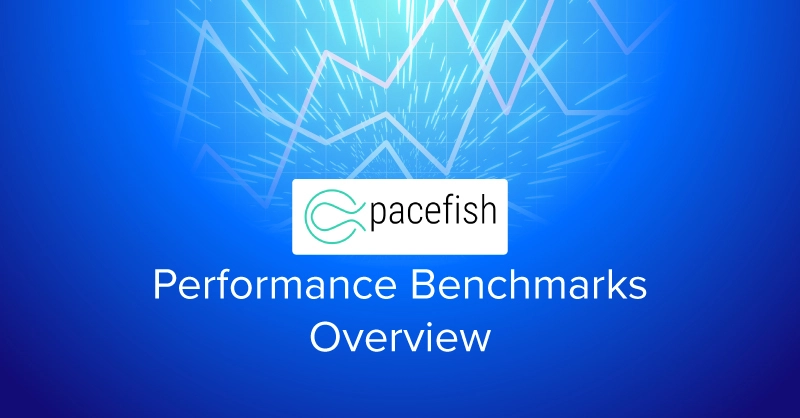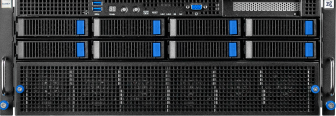
GPU Accelerated CFD in Numeric Systems' Pacefish
Computational Fluid Dynamics (CFD) requires speed and accuracy for practitioners and engineers to make educated design decisions. As models become increasingly complex, so does the time required to process and gather results.
Numeric Systems' Pacefish® is a CFD simulation software suite that prioritizes short turnaround times with reliable results featuring high GPU acceleration and scalability. Exxact partnered with Numeric Systems to evaluate the GPU performance using our GPU Workstations equipped with the most popular top-of-the-line professional GPUs:
Why GPU Acceleration Matters
GPU-accelerated computing has reached a point where it has been optimized to perform far greater than CPUs in most parallelized workloads. For engineers and researchers, this means they can iterate faster and model larger simulations.
Industries ranging from aerospace to automotive to civil engineering can benefit from incorporating GPU-accelerated computing into their computing infrastructure, reducing time-to-market while improving product quality. The ability to simulate larger, more detailed models also opens doors for innovation.
- Time: Less time to completion means more simulation tests can be run to fine-tune before production. This shorter wait time translates to getting results faster and accelerating the workflow process.
- Complexity: Increased speedup, even on highly complex models, enables better representations of the simulation. While GPU VRAM is limited compared to CPU RAM, new GPU releases have increased VRAM capacities ideal for visualization, simulation, and other HPC workloads. The NVIDIA RTX PRO 6000 Blackwell tested has 96GB of VRAM!
- Cost: A single GPU has the equivalent performance of hundreds of CPU cores. Deploying hundreds of CPU cores requires a cluster of compute servers, not to mention the total cost to run and maintain. However, a single- or multi-GPU workstation can be configured and deployed on your engineer's desk.
Pacefish GPU Benchmarks: NVIDIA RTX PRO 6000 Blackwell vs NVIDIA RTX 6000 Ada
Here we test the three top-of-the-line NVIDIA RTX GPUs. The main differences and advantages that NVIDIA RTX PRO Blackwell Series has over NVIDIA RTX Ada Lovelace generations are:
- New NVIDIA Blackwell GPU architecture with increased CUDA cores and raw FP32 performance
- New GDDR7 with higher memory bandwidth
- Double the VRAM to now 96GB from the previous 48GB
- Move towards PCIe 5.0 for higher bandwidth and data transfer rates
We also test both the 600W NVIDIA RTX PRO 6000 Blackwell and the 300W NVIDIA RTX PRO 6000 Blackwell Max-Q Workstation Edition GPUs to determine if the extra power draw delivers any sizable performance gains.
| NVIDIA RTX 6000 Ada | NVIDIA RTX PRO 6000 Blackwell Max-Q (300W) | NVIDIA RTX PRO 6000 Blackwell Workstation (600W) | |
| Average Performance in MVPS (Million Volumes per Second) | 777.78 | 1070.11 | 1129.33 |
| Relative Speedup (vs NVIDIA RTX 6000 Ada) | 1.0x | 1.38x | 1.45x |

In the Pacefish CFD workload, the speedup of NVIDIA RTX PRO 6000 Blackwell Series compared to NVIDIA RTX 6000 Ada is 1.45x for the 600W version and 1.38x for the 300W Max-Q edition. This is within the expected range, mirroring the Single Precision FP32 performance improvements: NVIDIA RTX 6000 Ada's 91.1 TFLOPS to NVIDIA RTX PRO 6000 Blackwell's 125 TFLOPS (125 TFLOPS ÷ 91.1 TFLOPS = 1.37x performance gain).
Pacefish does not show any significant impact from the higher memory bandwidth. Additionally, there are minimal performance gains when using the NVIDIA RTX PRO 6000 Blackwell Workstation 600W versus the 300W Max-Q Edition, showcasing similar performance.

When running problem sizes with small to large cell counts, we saw NVIDIA RTX PRO Blackwell Series deliver peak performance much quicker. We attribute this to the faster PCIe 5.0 lane speeds (versus PCIe 4.0) and the higher memory bandwidth that can saturate the GPU with data faster. This can also result in stronger scaling performance when utilizing multiple NVIDIA RTX PRO 6000 Blackwell Series GPUs. The following diagrams visualize this fast saturation:

Now, the most impactful improvement is that the NVIDIA RTX PRO 6000 Blackwell features 96GB of VRAM, doubling the 48GB in the NVIDIA RTX 6000 Ada. With strong scalability, engineers can accelerate extremely large and complex models. With the NVIDIA RTX PRO 6000 Blackwell Series, engineers can now simulate double the cell count size compared to NVIDIA RTX 6000 Ada GPUs.
Key Takeaways
- Performance Improvement: NVIDIA Blackwell GPUs show a speedup of 1.45x (at 600W) and 1.38x (at 300W) compared to Ada GPUs when running Pacefish simulations.
- Power Efficiency: Interestingly, the 300W NVIDIA Blackwell version performs almost as well as the 600W version, suggesting diminishing returns on power consumption for Pacefish workloads. This is good news for multi-GPU deployments using the NVIDIA RTX PRO 6000 Blackwell Max-Q (300W).
- Memory Advantage: The 96GB memory of NVIDIA RTX PRO 6000 Blackwell Series is a significant benefit, enabling double the simulation cell count size compared to NVIDIA RTX 6000 Ada.
- Strong Scaling: NVIDIA RTX PRO 6000 Blackwell Series shows better strong scaling performance, reaching maximum performance with smaller problem sizes compared to the NVIDIA RTX 6000 Ada GPU.
- Practical Benefits: The performance advantages reduce total simulation time, and the higher VRAM increases the simulation model sizes.
About Pacefish CFD Simulation Considerations
Exxact is working with Pacefish to offer compelling engineering simulation solutions for their CFD simulation suite. Here are some considerations for configuring your engineering computing solution:
AMD or Intel CPUs better for Pacefish?
Pacefish is not biased regarding Intel or AMD processors. Pacefish works with both platforms with negligible performance differences.
What are the system memory requirements for Pacefish?
The host system should have a 3:1 RAM to VRAM ratio. For instance, for two NVIDIA RTX PRO 6000 Blackwell GPUs with 96GB each (192GB total), the platform should ideally have 576GB of RAM. Having less than the ideal RAM will not cause problems, but most production runs require statistically post-processed results.
The statistical dataset usually consumes twice the amount of host memory as consumed on the GPUs for the transient simulation state. Having less host memory available may restrict production runs in the cell count, such that the system runs out of memory early before the setup is about to consume all the available VRAM.
Where to Purchase a System Configured with NVIDIA RTX PRO 6000 Blackwell?
Exxact is a high-performance computing solutions provider that builds custom multi-GPU workstations, GPU compute servers, and full computing clusters. Contact us today to get in touch with our sales engineers to configure your ideal CFD engineering solution.

Fueling Innovation with an Exxact Multi-GPU Server
Accelerate your workload exponentially with the right system optimized to your use case. Exxact 4U Servers are not just a high-performance computer; it is the tool for propelling your innovation to new heights.
Configure Now
NVIDIA RTX PRO 6000 Blackwell Series vs NVIDIA RTX 6000 Ada GPU Benchmark in Pacefish CFD
GPU Accelerated CFD in Numeric Systems' Pacefish
Computational Fluid Dynamics (CFD) requires speed and accuracy for practitioners and engineers to make educated design decisions. As models become increasingly complex, so does the time required to process and gather results.
Numeric Systems' Pacefish® is a CFD simulation software suite that prioritizes short turnaround times with reliable results featuring high GPU acceleration and scalability. Exxact partnered with Numeric Systems to evaluate the GPU performance using our GPU Workstations equipped with the most popular top-of-the-line professional GPUs:
Why GPU Acceleration Matters
GPU-accelerated computing has reached a point where it has been optimized to perform far greater than CPUs in most parallelized workloads. For engineers and researchers, this means they can iterate faster and model larger simulations.
Industries ranging from aerospace to automotive to civil engineering can benefit from incorporating GPU-accelerated computing into their computing infrastructure, reducing time-to-market while improving product quality. The ability to simulate larger, more detailed models also opens doors for innovation.
- Time: Less time to completion means more simulation tests can be run to fine-tune before production. This shorter wait time translates to getting results faster and accelerating the workflow process.
- Complexity: Increased speedup, even on highly complex models, enables better representations of the simulation. While GPU VRAM is limited compared to CPU RAM, new GPU releases have increased VRAM capacities ideal for visualization, simulation, and other HPC workloads. The NVIDIA RTX PRO 6000 Blackwell tested has 96GB of VRAM!
- Cost: A single GPU has the equivalent performance of hundreds of CPU cores. Deploying hundreds of CPU cores requires a cluster of compute servers, not to mention the total cost to run and maintain. However, a single- or multi-GPU workstation can be configured and deployed on your engineer's desk.
Pacefish GPU Benchmarks: NVIDIA RTX PRO 6000 Blackwell vs NVIDIA RTX 6000 Ada
Here we test the three top-of-the-line NVIDIA RTX GPUs. The main differences and advantages that NVIDIA RTX PRO Blackwell Series has over NVIDIA RTX Ada Lovelace generations are:
- New NVIDIA Blackwell GPU architecture with increased CUDA cores and raw FP32 performance
- New GDDR7 with higher memory bandwidth
- Double the VRAM to now 96GB from the previous 48GB
- Move towards PCIe 5.0 for higher bandwidth and data transfer rates
We also test both the 600W NVIDIA RTX PRO 6000 Blackwell and the 300W NVIDIA RTX PRO 6000 Blackwell Max-Q Workstation Edition GPUs to determine if the extra power draw delivers any sizable performance gains.
| NVIDIA RTX 6000 Ada | NVIDIA RTX PRO 6000 Blackwell Max-Q (300W) | NVIDIA RTX PRO 6000 Blackwell Workstation (600W) | |
| Average Performance in MVPS (Million Volumes per Second) | 777.78 | 1070.11 | 1129.33 |
| Relative Speedup (vs NVIDIA RTX 6000 Ada) | 1.0x | 1.38x | 1.45x |

In the Pacefish CFD workload, the speedup of NVIDIA RTX PRO 6000 Blackwell Series compared to NVIDIA RTX 6000 Ada is 1.45x for the 600W version and 1.38x for the 300W Max-Q edition. This is within the expected range, mirroring the Single Precision FP32 performance improvements: NVIDIA RTX 6000 Ada's 91.1 TFLOPS to NVIDIA RTX PRO 6000 Blackwell's 125 TFLOPS (125 TFLOPS ÷ 91.1 TFLOPS = 1.37x performance gain).
Pacefish does not show any significant impact from the higher memory bandwidth. Additionally, there are minimal performance gains when using the NVIDIA RTX PRO 6000 Blackwell Workstation 600W versus the 300W Max-Q Edition, showcasing similar performance.

When running problem sizes with small to large cell counts, we saw NVIDIA RTX PRO Blackwell Series deliver peak performance much quicker. We attribute this to the faster PCIe 5.0 lane speeds (versus PCIe 4.0) and the higher memory bandwidth that can saturate the GPU with data faster. This can also result in stronger scaling performance when utilizing multiple NVIDIA RTX PRO 6000 Blackwell Series GPUs. The following diagrams visualize this fast saturation:

Now, the most impactful improvement is that the NVIDIA RTX PRO 6000 Blackwell features 96GB of VRAM, doubling the 48GB in the NVIDIA RTX 6000 Ada. With strong scalability, engineers can accelerate extremely large and complex models. With the NVIDIA RTX PRO 6000 Blackwell Series, engineers can now simulate double the cell count size compared to NVIDIA RTX 6000 Ada GPUs.
Key Takeaways
- Performance Improvement: NVIDIA Blackwell GPUs show a speedup of 1.45x (at 600W) and 1.38x (at 300W) compared to Ada GPUs when running Pacefish simulations.
- Power Efficiency: Interestingly, the 300W NVIDIA Blackwell version performs almost as well as the 600W version, suggesting diminishing returns on power consumption for Pacefish workloads. This is good news for multi-GPU deployments using the NVIDIA RTX PRO 6000 Blackwell Max-Q (300W).
- Memory Advantage: The 96GB memory of NVIDIA RTX PRO 6000 Blackwell Series is a significant benefit, enabling double the simulation cell count size compared to NVIDIA RTX 6000 Ada.
- Strong Scaling: NVIDIA RTX PRO 6000 Blackwell Series shows better strong scaling performance, reaching maximum performance with smaller problem sizes compared to the NVIDIA RTX 6000 Ada GPU.
- Practical Benefits: The performance advantages reduce total simulation time, and the higher VRAM increases the simulation model sizes.
About Pacefish CFD Simulation Considerations
Exxact is working with Pacefish to offer compelling engineering simulation solutions for their CFD simulation suite. Here are some considerations for configuring your engineering computing solution:
AMD or Intel CPUs better for Pacefish?
Pacefish is not biased regarding Intel or AMD processors. Pacefish works with both platforms with negligible performance differences.
What are the system memory requirements for Pacefish?
The host system should have a 3:1 RAM to VRAM ratio. For instance, for two NVIDIA RTX PRO 6000 Blackwell GPUs with 96GB each (192GB total), the platform should ideally have 576GB of RAM. Having less than the ideal RAM will not cause problems, but most production runs require statistically post-processed results.
The statistical dataset usually consumes twice the amount of host memory as consumed on the GPUs for the transient simulation state. Having less host memory available may restrict production runs in the cell count, such that the system runs out of memory early before the setup is about to consume all the available VRAM.
Where to Purchase a System Configured with NVIDIA RTX PRO 6000 Blackwell?
Exxact is a high-performance computing solutions provider that builds custom multi-GPU workstations, GPU compute servers, and full computing clusters. Contact us today to get in touch with our sales engineers to configure your ideal CFD engineering solution.

Fueling Innovation with an Exxact Multi-GPU Server
Accelerate your workload exponentially with the right system optimized to your use case. Exxact 4U Servers are not just a high-performance computer; it is the tool for propelling your innovation to new heights.
Configure Now



.jpg?format=webp)